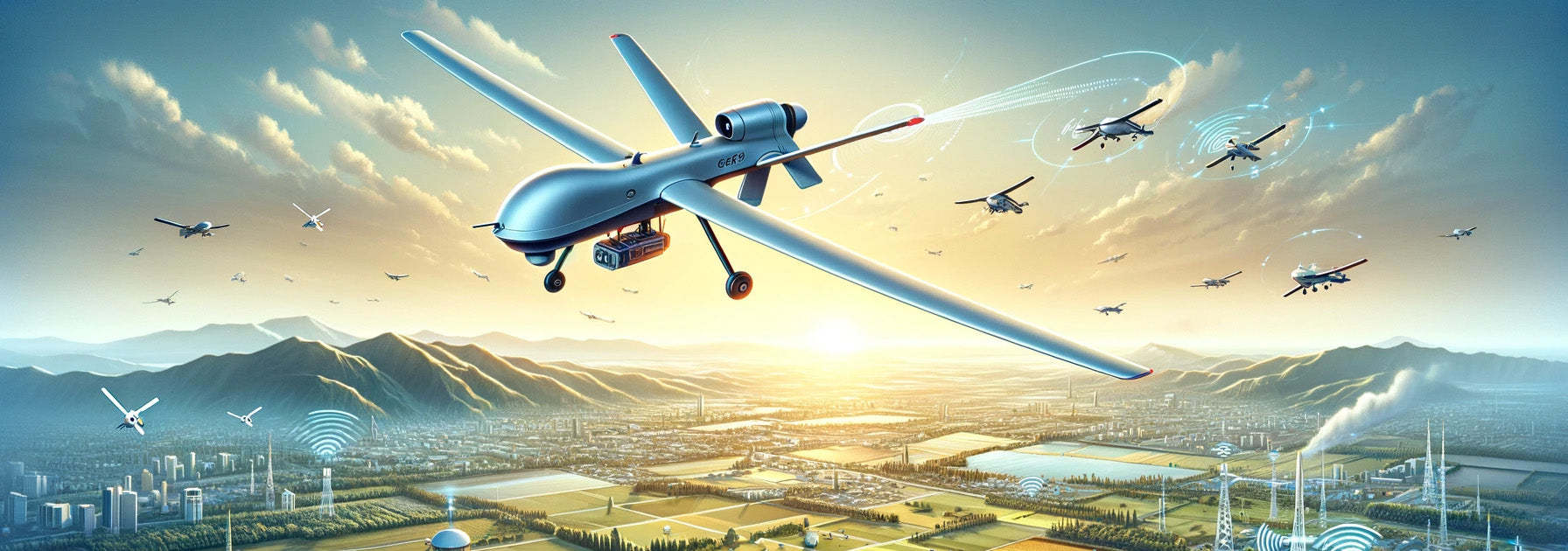
Aviation and Satellite Networks
- 26 Mar, 2024
- Posted by: Michael Mathison
Aviation and Satellite Networks
The integration of satellite networks into the aviation industry marks a pivotal advancement, dramatically transforming how aircraft navigate, communicate, and ensure passenger safety and comfort. These networks offer unparalleled global coverage, enabling real-time communication and data exchange between aircraft in flight and ground control, regardless of the aircraft's location. This connectivity is crucial for modern air traffic management, enhancing flight safety through improved route planning, weather forecasting, and collision avoidance systems.
Moreover, satellite technology has revolutionized the passenger experience by providing in-flight broadband services, allowing travelers to stay connected and entertained throughout their journey. As such, satellite networks are integral to the aviation industry's continuous pursuit of safety, efficiency, and customer satisfaction in an increasingly connected world.

General Aviation
Satellite networks have a profound impact on general aviation, enhancing navigation, safety, and communication capabilities for a wide range of aircraft, from private planes to business jets. These networks facilitate a variety of essential services that contribute to the efficiency and reliability of general aviation operations. Here’s how:
Explanation:
General aviation benefits from satellite networks through improved access to real-time weather information, global positioning services (GPS), and enhanced communication with air traffic control and ground operations. This connectivity is crucial for flight planning, en-route navigation, and emergency management, ensuring pilots can make informed decisions and maintain safe flight paths.
Additionally, satellite technology supports the modernization of the air traffic management system, facilitating more direct routes and efficient airspace utilization. For passengers, satellite networks enable in-flight connectivity, allowing internet access, streaming services, and satellite phone calls. This integration of satellite technology into general aviation operations significantly increases safety, operational flexibility, and the overall flying experience.
How General Aviation is Affected by Satellite Networks:
-
Improved Navigation: Satellite GPS provides precise navigation and timing information, essential for flight accuracy and safety.
-
Enhanced Communication: Enables reliable, real-time communication with air traffic control, ground support, and between aircraft, essential for coordinating flights and managing airspace.
-
Real-time Weather Updates: Pilots have access to up-to-date weather information and forecasts, crucial for flight planning and avoiding adverse weather conditions.
-
Emergency Services: Satellite networks support emergency locator transmitters (ELTs) and personal locator beacons (PLBs) for rapid response in case of emergencies.
-
Air Traffic Management: Supports the NextGen air traffic management system, allowing for more efficient routing and reduced fuel consumption.
-
In-flight Connectivity: Provides passengers with internet access, enabling email, web browsing, and video streaming during flights.
-
Flight Tracking: Allows for the continuous tracking of aircraft, enhancing flight safety and operational awareness.
-
Global Coverage: Offers connectivity even in remote areas, ensuring that general aviation aircraft are never out of reach, regardless of their location.
-
Satellite Phone Communications: Enables voice communication from remote locations or when flying over large bodies of water where traditional radio communication may not be available.
-
Data Transmission: Facilitates the transmission of flight data for maintenance, performance analysis, and compliance with regulatory requirements.
Satellite networks thus play a crucial role in modernizing general aviation, offering technologies that enhance safety, improve efficiency, and provide connectivity, significantly impacting how general aviation operations are conducted and experienced.

Business Jet
Satellite networks profoundly impact the operation and passenger experience of business jets, integrating advanced communication and navigation technologies that redefine efficiency and luxury in private aviation. Here’s how:
Explanation:
For business jets, satellite networks ensure seamless global connectivity, essential for both operational needs and the high standards of comfort expected by passengers. These networks facilitate precise global positioning for accurate navigation and efficient route planning, enabling business jets to fly optimized paths that save time and fuel. Real-time communication with air traffic control and ground operations is vital for safety and logistical coordination, made reliable through satellite technology.
Additionally, satellite networks provide business jet passengers with in-flight connectivity, including internet access, live television, and video conferencing capabilities, allowing for productivity and entertainment during flights. This level of connectivity is crucial for meeting the demands of today’s global business environment, where being disconnected is not an option.
How Business Jets are Affected by Satellite Networks:
-
Global Navigation: Satellite GPS provides precise navigation, enabling business jets to traverse global routes efficiently.
-
In-flight Connectivity: Offers high-speed internet access, allowing passengers to work, conduct video conferences, or relax with streaming services.
-
Real-Time Weather Updates: Pilots receive up-to-date weather information, crucial for avoiding turbulence and planning the safest and most comfortable routes.
-
Enhanced Communication: Ensures constant communication with air traffic control and ground services, critical for safety and operational coordination.
-
Flight Optimization: Satellite data supports dynamic flight planning, allowing for route adjustments in response to weather changes or airspace restrictions.
-
Safety and Emergency Services: Satellite networks support onboard safety systems, providing real-time distress signaling and communication in emergencies.
-
Entertainment Services: Enables live television and satellite radio, offering a wide range of entertainment options for passengers.
-
Remote Monitoring: Allows for the remote monitoring of aircraft systems, supporting predictive maintenance and operational efficiency.
-
Regulatory Compliance: Facilitates electronic reporting and compliance with flight operation regulations through secure data transmission.
-
Market Competitiveness: Enhances the appeal of business jets as a mode of travel, offering unparalleled connectivity that meets the needs of business leaders and high-net-worth individuals.
Satellite networks have become integral to the business jet sector, delivering critical capabilities that enhance navigation, safety, and the in-flight experience. This technology ensures that business jets remain at the forefront of aviation, offering fast, efficient, and connected travel options that cater to the needs of the modern business traveler.

Commercial
Satellite networks significantly enhance the operations and passenger experience of commercial airplanes, facilitating advancements in communication, navigation, safety, and in-flight services. These networks provide the backbone for modern air travel, ensuring that airplanes remain connected anywhere in the world. Here’s how:
Explanation:
For commercial aviation, satellite networks offer critical support for cockpit communications, allowing pilots and air traffic controllers to exchange vital information for flight safety and efficiency. This technology enables precise GPS navigation, improving route accuracy and fuel efficiency while reducing the risk of in-air collisions. Furthermore, satellite connectivity is essential for real-time weather updates, ensuring pilots can navigate around adverse conditions.
From a passenger perspective, satellite networks transform the in-flight experience by providing broadband internet access, live television, and on-demand content, making long flights more enjoyable and productive. Additionally, satellite technology plays a crucial role in global tracking and emergency response, enhancing the overall safety of commercial air travel.
How Commercial Airplanes are Affected by Satellite Networks:
-
Cockpit Communications: Enables secure and continuous communication between the cockpit crew and air traffic control, crucial for flight operations and safety.
-
GPS Navigation: Satellite GPS systems offer precise navigation, allowing for optimized flight paths and improved fuel efficiency.
-
Real-time Weather Updates: Provides pilots with up-to-date weather information, essential for avoiding turbulence and planning the safest routes.
-
In-flight Connectivity: Offers passengers high-speed internet access, allowing for web browsing, email, social media, and streaming services during the flight.
-
Live Television and Entertainment: Enables access to live TV broadcasts and a vast library of on-demand content, enhancing passenger entertainment.
-
Global Flight Tracking: Satellite networks support the global tracking of commercial airplanes, enhancing safety and operational monitoring.
-
Emergency Communications: Facilitates immediate communication in emergencies, including the transmission of distress signals and coordination with rescue services.
-
Operational Efficiency: Supports airline operations with real-time data on aircraft performance, maintenance needs, and logistical coordination.
-
Passenger Services: Enables real-time flight updates and services for passengers, improving the customer service experience.
-
Safety and Regulatory Compliance: Enhances overall flight safety and aids airlines in meeting international regulatory requirements for communication and tracking.
Satellite networks are integral to the commercial aviation industry, offering essential technologies that ensure safety, navigational accuracy, and connectivity. These advancements not only improve operational efficiency and compliance but also significantly enhance the travel experience for passengers worldwide.

UAV
Satellite networks play a pivotal role in the operation and expansion of Unmanned Aerial Vehicles (UAVs) within the aviation industry, offering critical support for communication, navigation, and data transmission. These networks enable UAVs to perform a wide range of activities, from commercial operations and surveillance to environmental monitoring and search and rescue missions, with increased efficiency and safety. Here’s how:
Explanation:
For UAVs to operate beyond visual line of sight (BVLOS) and in remote areas, reliable communication with control stations and other airspace users is essential. Satellite networks provide this global coverage, ensuring UAVs can maintain constant contact regardless of their geographic location. This connectivity is crucial for transmitting real-time data, receiving flight commands, and sharing airspace with manned aircraft safely.
Additionally, satellite technology allows for precise GPS navigation, facilitating accurate and autonomous flight paths. The ability to transmit high-resolution imagery and other sensor data in real time supports a range of applications, from disaster response to infrastructure inspection, making UAVs invaluable tools in modern aviation and beyond.
How UAVs in the Aviation Industry are Affected by Satellite Networks:
-
Enhanced Communication: Enables real-time communication between UAVs and ground control, essential for safe and efficient operations.
-
Global Navigation: Provides accurate GPS data for precise navigation and flight planning, crucial for autonomous operations.
-
Real-time Data Transmission: Facilitates the immediate transfer of sensor data, including high-resolution imagery and environmental readings, to users or processing centers.
-
Beyond Visual Line of Sight (BVLOS) Operations: Satellite connectivity allows UAVs to safely operate beyond visual line of sight, expanding their operational capabilities.
-
Air Traffic Integration: Supports the integration of UAVs into the broader air traffic management system, ensuring they can coexist safely with manned aircraft.
-
Disaster Response and Monitoring: Enables UAVs to quickly assess disaster-impacted areas, supporting emergency response efforts and environmental monitoring.
-
Infrastructure Inspection: Allows for the remote inspection of critical infrastructure, reducing the need for human exposure to hazardous conditions.
-
Agricultural Monitoring: Supports precision agriculture practices by providing data on crop health, soil conditions, and moisture levels.
-
Surveillance and Security: Enhances surveillance capabilities for border security, maritime monitoring, and wildlife protection.
-
Search and Rescue Operations: Improves the efficiency of search and rescue missions by providing broad-area surveillance and pinpointing locations of interest.
Satellite networks are essential for maximizing the potential and safety of UAVs in the aviation industry, offering solutions that extend their range, improve their capabilities, and ensure their integration into global airspace. This technology has enabled UAVs to become versatile tools for a variety of commercial, governmental, and humanitarian applications, underscoring their growing importance in modern aviation.

Rotorcraft
Satellite networks significantly enhance the capabilities and operational efficiency of rotorcraft, including helicopters and other vertical takeoff and landing (VTOL) aircraft, within the aviation industry. These networks provide critical support for navigation, communication, and safety, especially vital in remote, underserved, or challenging environments where rotorcraft often operate. Here’s how:
Explanation:
For rotorcraft, which frequently undertake missions in areas lacking ground-based navigational aids, satellite networks offer indispensable navigation and communication solutions. This technology enables precise GPS guidance, facilitating safer and more efficient flight paths even in visually demanding or geographically complex environments. Satellite communication (satcom) systems ensure that rotorcraft remain in constant contact with air traffic control, ground operations, and emergency services, crucial for coordinating rescue missions, medical evacuations, and disaster response efforts.
Additionally, real-time weather updates and environmental monitoring via satellite networks help pilots navigate safely around adverse weather conditions, significantly reducing the risk of accidents. The integration of satellite technology into rotorcraft operations not only enhances mission capabilities but also supports the broader goals of safety and efficiency in the aviation industry.
How Rotorcraft in the Aviation Industry are Affected by Satellite Networks:
-
Enhanced Navigation: Provides accurate GPS positioning and navigation, essential for precise flight operations and route planning in challenging environments.
-
Reliable Communication: Ensures uninterrupted communication with ground control, air traffic management, and emergency services, vital for operational coordination and safety.
-
Real-time Weather Information: Offers access to up-to-date weather forecasts and alerts, enabling pilots to avoid hazardous conditions and plan safer flights.
-
Mission Coordination: Facilitates the coordination of complex missions, such as search and rescue, medical evacuations, and disaster relief, by providing a reliable communication link.
-
Remote Area Operations: Enables effective operation in remote or underserved areas by providing essential navigation and communication capabilities where ground-based infrastructure is limited or non-existent.
-
Safety Enhancements: Supports safety management systems by allowing for the transmission of critical flight data and monitoring of flight parameters in real time.
-
Air Traffic Integration: Aids in the safe integration of rotorcraft into crowded airspace, reducing the risk of collisions and enhancing overall airspace management.
-
Environmental Monitoring: Utilizes satellite data for environmental assessment and monitoring, supporting missions related to wildlife conservation, forest fire detection, and pollution control.
-
Global Coverage: Ensures global operability, allowing rotorcraft to undertake international missions with confidence in their navigation and communication systems.
-
Operational Efficiency: Improves overall operational efficiency by optimizing flight routes, reducing fuel consumption, and minimizing flight delays.
Satellite networks are vital for advancing the capabilities of rotorcraft within the aviation industry, ensuring these versatile aircraft can perform their wide range of missions more safely and efficiently. This technology is particularly crucial for operations in remote, challenging, or critical environments, where reliable navigation and communication are essential for success.

Air Cargo
Satellite networks profoundly impact the air cargo sector within the aviation industry, enhancing operational efficiency, safety, and global connectivity. These networks provide critical support for the tracking, communication, and management of air cargo operations, from takeoff to landing and beyond. Here’s how:
Explanation:
Satellite networks enable real-time tracking of air cargo, ensuring that carriers and customers alike can monitor the status and location of shipments around the clock, anywhere in the world. This connectivity is crucial for optimizing flight routes, managing air traffic, and responding swiftly to any logistical challenges that may arise. Furthermore, satellite communication facilitates the exchange of vital information between aircraft, ground crews, and logistic centers, enhancing coordination and efficiency across the supply chain.
Weather forecasting services, powered by satellite data, allow air cargo operators to plan routes that avoid adverse weather, minimizing delays and ensuring the safety of the cargo and crew. Additionally, satellite technology supports the automation of air cargo operations, including inventory management and cargo handling, further streamlining the logistics process.
How Air Cargo in the Aviation Industry is Affected by Satellite Networks:
-
Real-Time Cargo Tracking: Allows for the monitoring of cargo shipments globally, enhancing visibility and security throughout the supply chain.
-
Enhanced Communication: Ensures reliable, real-time communication between the aircraft, ground control, and logistic centers, crucial for efficient operations.
-
Weather Forecasting: Provides access to up-to-date weather information, enabling operators to plan safer and more efficient flight paths.
-
Flight Planning and Management: Supports dynamic flight planning, allowing for route adjustments in response to changing conditions or airspace restrictions.
-
Safety and Emergency Response: Facilitates quick communication in case of emergencies, improving response times and overall safety.
-
Supply Chain Coordination: Enhances the coordination of logistics operations, from warehousing and inventory management to delivery, through seamless data exchange.
-
Automated Cargo Handling: Satellite connectivity supports the automation of cargo handling processes, reducing manual errors and increasing efficiency.
-
Regulatory Compliance: Aids in meeting international aviation and customs regulations by facilitating the secure transmission of cargo documentation and compliance data.
-
Environmental Monitoring: Enables operators to track their environmental impact, supporting efforts to reduce emissions and improve sustainability in cargo operations.
-
Global Reach: Ensures that air cargo operations can be conducted anywhere in the world, expanding the market reach of carriers and shippers.
Satellite networks are indispensable for the modern air cargo industry, offering solutions that enhance the safety, efficiency, and reliability of global cargo operations. This technology not only improves operational capabilities but also drives innovation in logistics management, meeting the demands of an increasingly interconnected and fast-paced global economy.








